As the saying goes “Do clothes maketh the man”? a statement made a very long time ago, however is still related to today’s modern society. The way a man dresses can partly influence how other people perceive him, or to be judged by what he’s wearing, how it’s worn, and whether he’s comfortable wearing it.
Dressing in vintage clothes can indeed contribute to a unique and stylish look, but whether they make a gentleman depends on how they are worn and the demeanor of the individual, rather than the clothes themselves. A gentleman is typically characterize by qualities such as politeness, respectfulness, kindness and integrity. Clothing can certainly be a part of expressing these qualities, but they don’t solely define a gentleman. How one carries themselves, treats others, and conducts themselves in various situations often matters more.
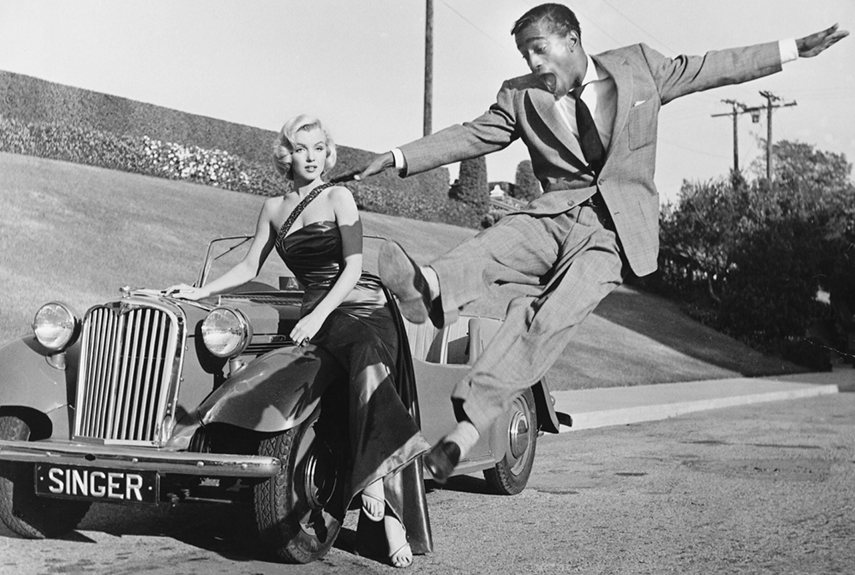
The different Classes
Throughout history, clothing has often been used as a symbol of social status, wealth, and power. In man societies, especially in the bygone era, what one wore often indicated their social standing, regardless of whether they were rich or poor. Wealthy individuals typically had access to finer materials, luxurious fabrics, and elaborate, well-tailored garments that were often custom-made. The Victorian gentleman’s outfit was often more intricate, adorned with expensive embellishments like jewels, embroidery, or fine detailing, which served as visible markers of their affluence and status in society. On the other hand, individuals with lower socioeconomic backgrounds often had clothing made from simpler, more affordable materials. These garments where typically plain, less intricate, and designed primarily for functionality rather than fashion and often more practical and durable, meant to withstand hard work or harsh conditions.
The distinction between rich and poor through clothing was previlant in many historical societies that helped reinforce societal hierarchies. However, it’s important to note that there have been exceptions, variations, and shifts in fashion trends that challenged or altered these norms throughout different periods of history.
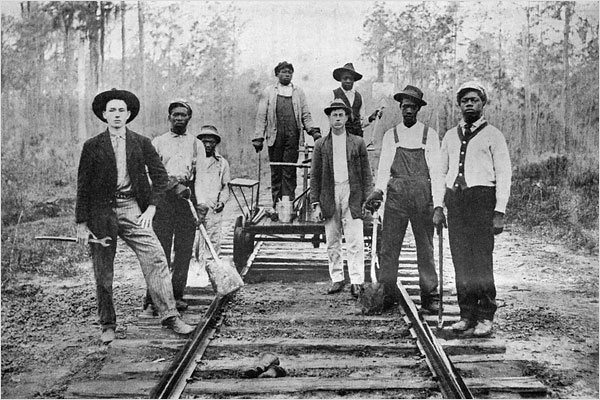
The Edwardian Gentleman
A Gentleman, is a man derived from a good family, or someone well born, comes from the french word Gentilhomme. In the Western world gentlemen’s fashion underwent significant changes throughout the decades. Here’s a bit of history, plus a summary of what both classes usually wore during those times.
In the 1900’s-1910’s suits were normally worn for every day wear. They consisted of a three- piece ensemble with a tailored jacket, waistcoat or vest, and trousers. The colours at the time were dark brown, navy or grey with black worn mainly for mourning. Jackets had a structured, tailored fit with wide lapels and often would feature tails in the back. Shirts were usually high-collared with stiff collars that required detachable collar studs. Accessories like bow ties, long ties, pocket squares and hats such as bowler or top hats, for formal occasions, were common. During this period, the wealthy had formal wear for evening events that included tailcoats or tuxedos, which were elaborate or meticulously tailored. As a starting point – some trendy Steampunk Edwardian inspired fashion pieces (including shirts) can be found here, while other suits such as tails can be found at Etsy.
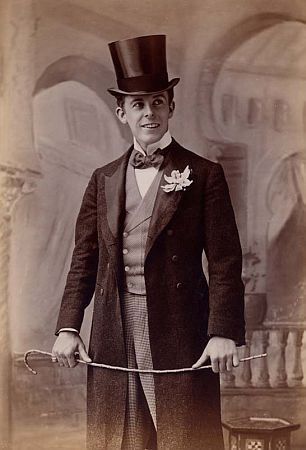
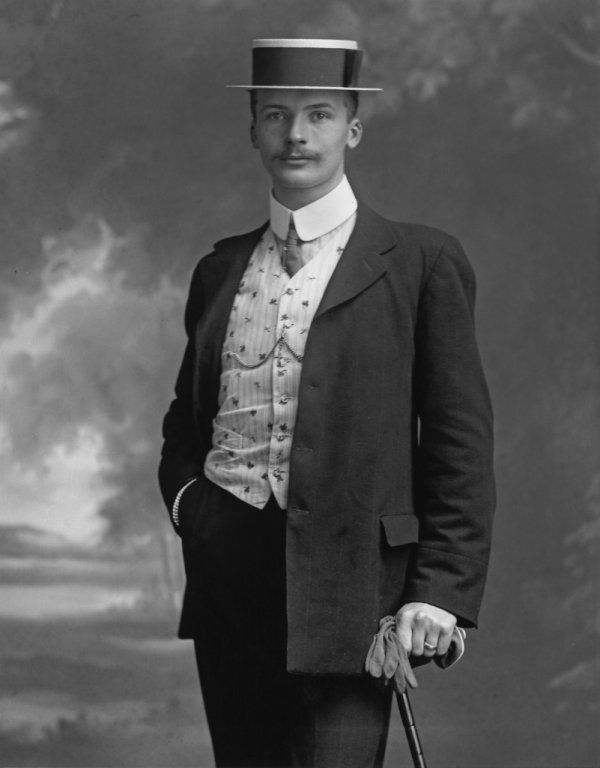
The Edwardian era male fashion called for elegance, opulance and strict social rules modeled by the wealthy, but an era known for the Tall, Long and Lean with the use of expensive fabrics and trimmings, favouring a distinguised mature look. This look comprised of blazers, overcoats or sack coats (learn more online) lounge suits, morning suits, smoking jackets, tail coats and waist coats. The trousers were either matching or contrasting with the coat or waistcoat in different variations. They would also don pink bow ties and pink shirts with detachable varied collars in white, or other pastel shirts with round collars could also suffice for a smart edwardian look – learn more here. Some sporting suits had a herringbone pattern throughout, but as new sports were emerging, each one had their own style. Tweed or Norfolk jackets can be found here through Etsy. However hunting still remained a popular choice for weekend jaunts, so a single breasted loose fitting Norfolk jacket in tweed was worn teaming it with long boots and knickerbocker pants – can be bought at affordable prices. Other fabrics such as flannel and knitwear were used widely for many sporting outfits. Formal suits would always accompany a bowler, or formal hat with elegant gloves and a pocket watch, depending on the occasion. Walking canes or sticks were a must to complete the gentlemen accessories – learn more about these here. Flat caps were a popular choice for casual or sporting activities with their popularity remaining for many decades to follow.
Department stores during time commenced to stock ready to wear fashions, making it possible for men to own a variety of outfits without having to visit a Tailor each time.
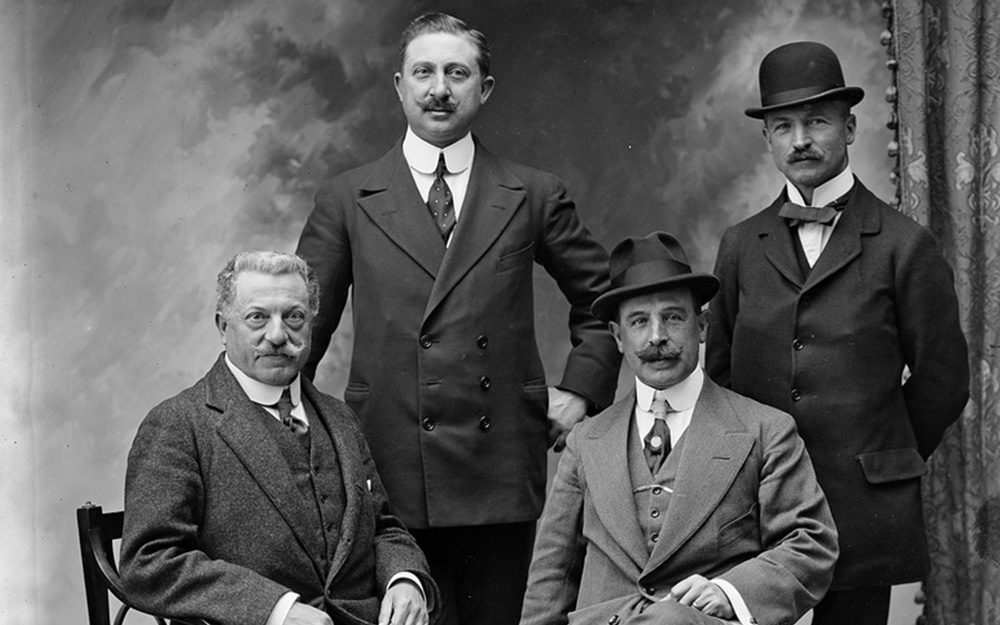

Working class factory workers wore uniforms consisting of protective aprons with white shirts or shirts and ties worn underneath, depending on the role of the job, but donning flat caps, while others working outside would wear thicker protective clothing such as leather or wool jackets or heavy sweaters with trousers made from canvas, cordouroy or duck cloth.
The popular flat caps were once again worn, just like the newspaper boy who was later named the newsboy cap or bakerboy hat. These hats are located online at Etsy so learn more or purchase.
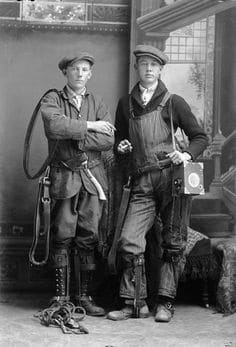
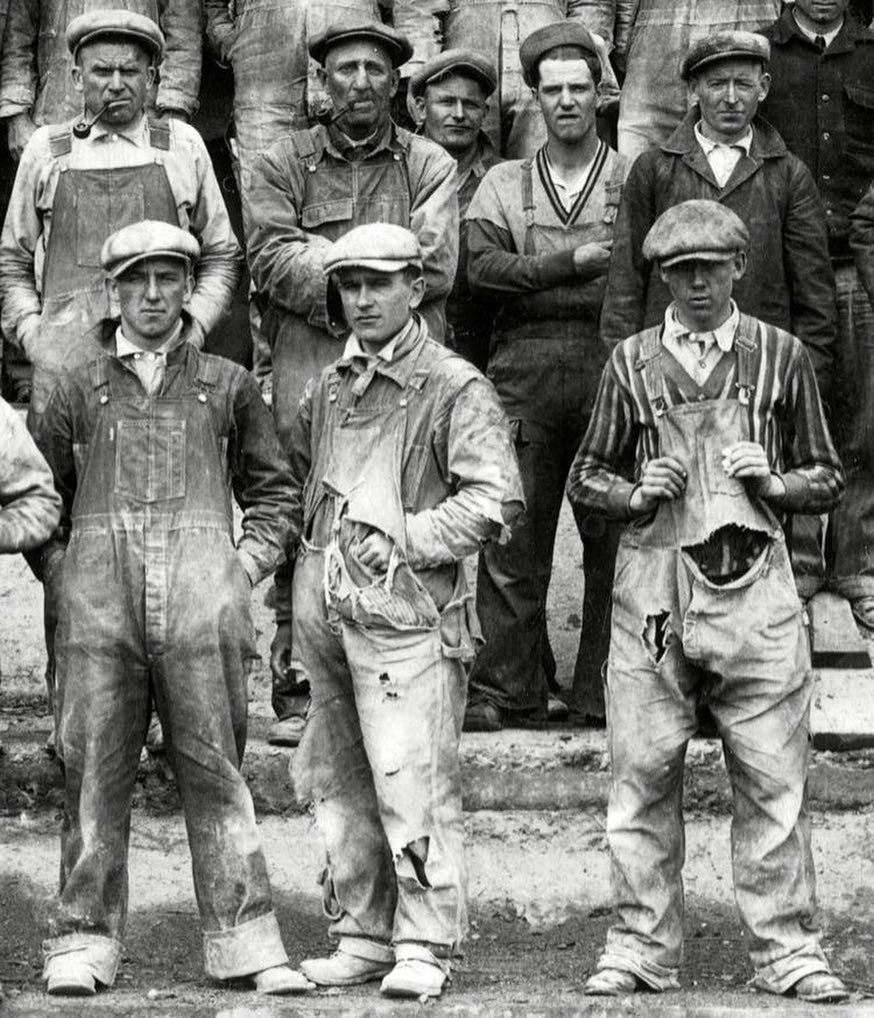
and flat caps
The Gangster – roaring 20’s
Gangsters were formed during the American Prohibition and the early part of the Great Depression. War was brewing in Europe and in America pro Nazi groups believed that fascism was the answer to American despair.
From the year 1924 saw a big rise in crime levels, with prohibition making the nation turn “dry” from 1920 onwards, over 1300 gangs forming in one city alone, turning Chicago streets into a war zone as gangland clashes were happening everywhere between rival powerful gangs led by the likes of Al “scarface” Capone and George “bugs” Moran. Bootlegging profits meant they were cashed up, and by arming themselves with “Tommy Guns“ better known as Thompson Submachine Guns, thus paying off Politicians and Police, were able to operate with impunity. Professional criminals dominated cities across America and 12,000 murders took place each year till 1926.
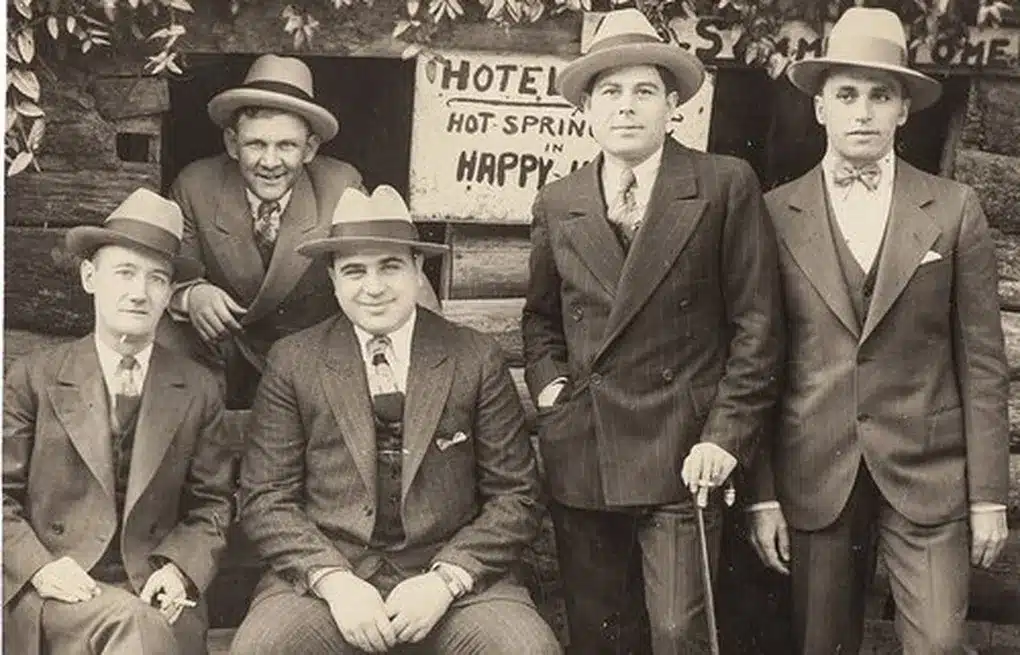
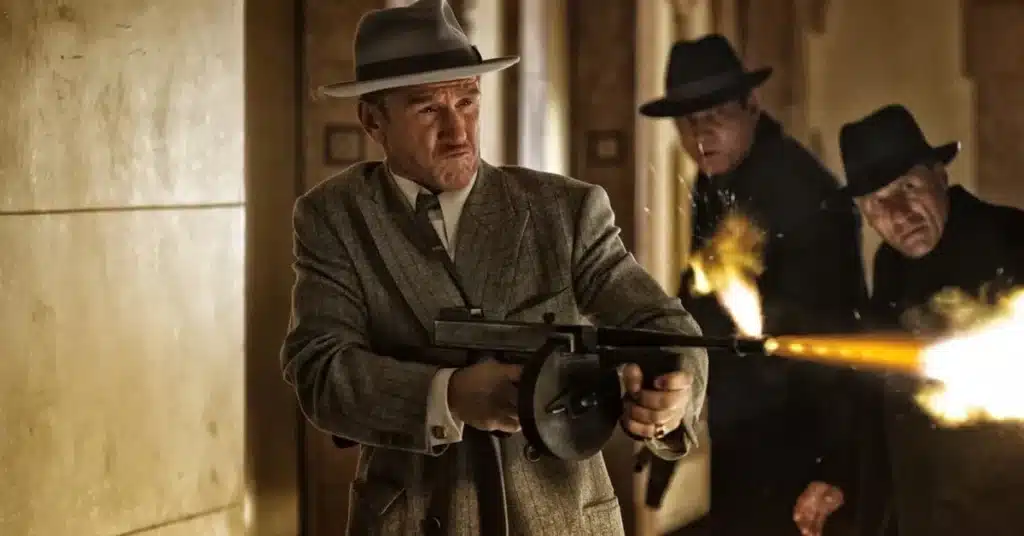
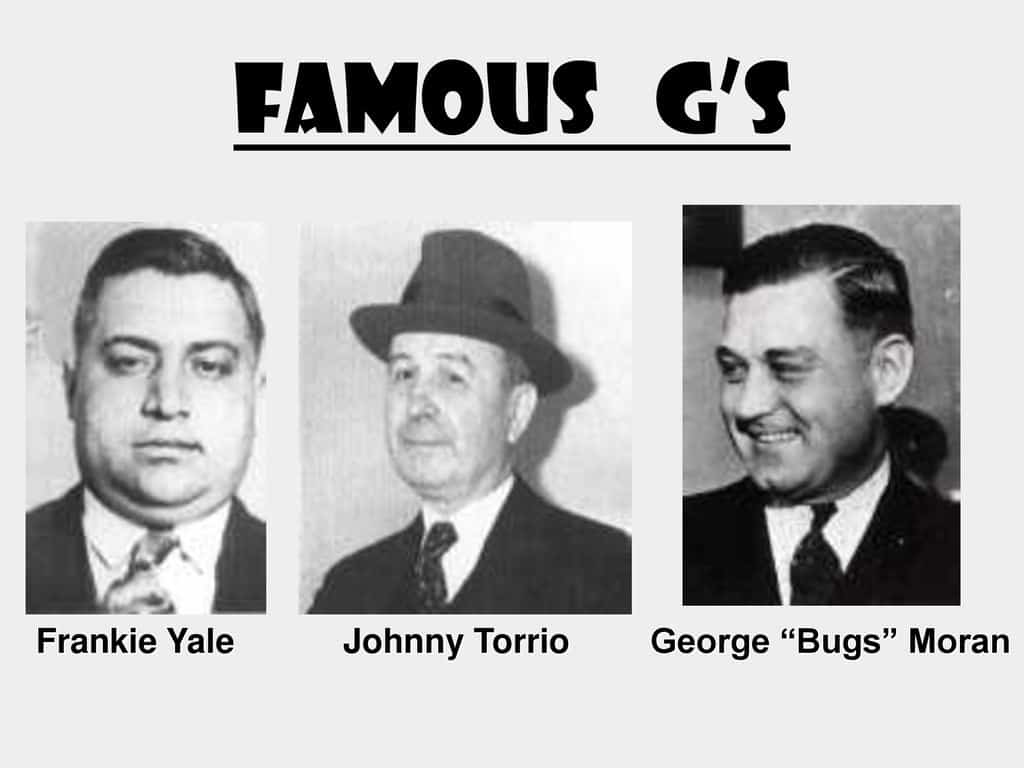
The Silhouette of men’s fashion shifted in the 1920’s. Suits became less formal, with a looser and more relaxed fit. Jackets had a straighter cut, trousers were wider, and waistcoats became less common. Two tone or pattern suits, such as pinstripes, gained popularity. Shirt collars became softer and less stiff compared to the previous decade. Accessories like wide brimmed fedora hats, tie pins, cuff links and walking sticks became fashionable. Learn more on how you can purchase these hats through Amazon today.
Gangster or Italian American Mafia (The Mob) as the Sicilians were called, fancied themselves sharply dressed in heavy suits adorned with tie clips, smart ties, arm bands and round collars, (though generally not considered a gentleman). The 20’s gangster men’s costume or outfit, was a 3 piece single or double breasted jackets and often in stripes other than black and teamed with contrasting ties, two toned shoes or shoe spatter guards that (Al Capone liked to wear) covering a plain shoe, and black or white band fedora hat. Working class Gangsters could only afford a 2 piece suit, whether it was a jacket and pants or a vest and pants. Pleated trousers with cuffs were introduced in the late 20’s, after trousers with flat fronts and narrow legs were the standard in the early 1920’s. Here are some pin stripe suits you may consider. During the warm seasons, the 20’s gangster suit comprised of a light coloured suit with trousers held up with suspenders and straw boater hat – which made a fashion statement in that era.
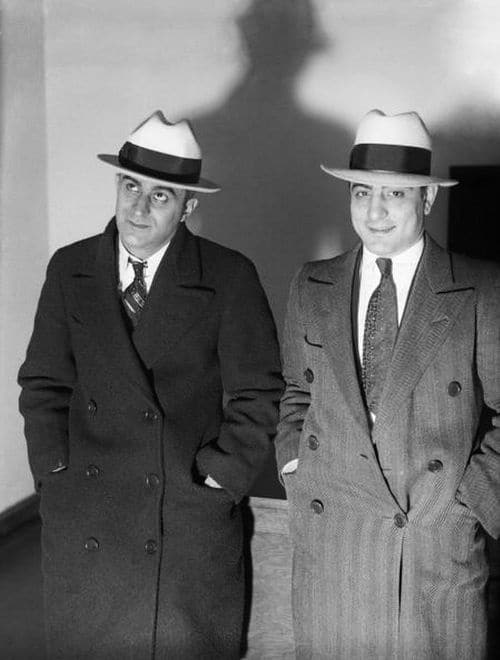
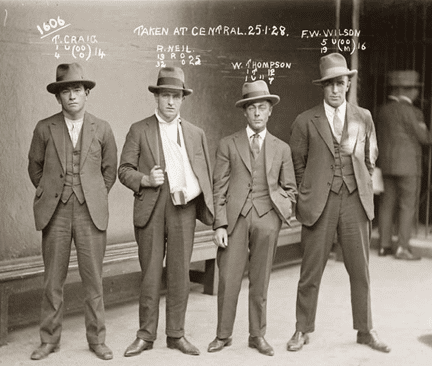
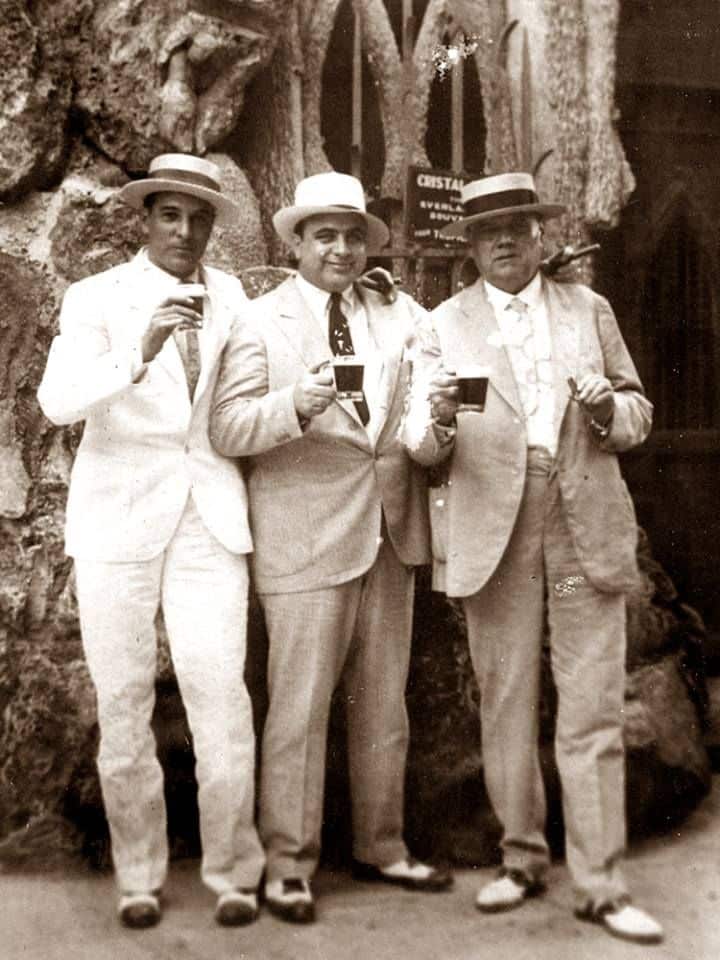
wing tip oxfords
Civilian men and gentlemen wore well made tailored striped suits in similar previous colours of grey, brown, blue, dark green and ivory with the occasional pastel, but never black as this was for mourning only. Accessories like black patent shoes or boots, stiff collars, waistcoats or vests, gloves, white ties, trilby’s and tails with spats and a cane were popular attire. Heavier fabrics were used such as wool, tweed, mohair flannel or cordouroy. The suit style included two sets of flap pockets and when buttoned up would completely cover the vest distinctive for that era. Spring and Summer saw lighter shades and with the discovery of natural sharkskin fabric pastel tones made their way into fashion for men including grey blue, grey green, lilac and light green. White tuxedo’s still remained popular for holiday evening attire.
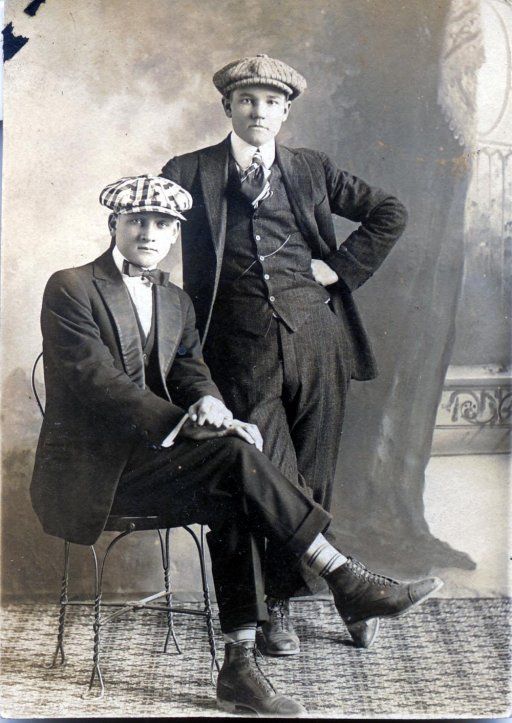
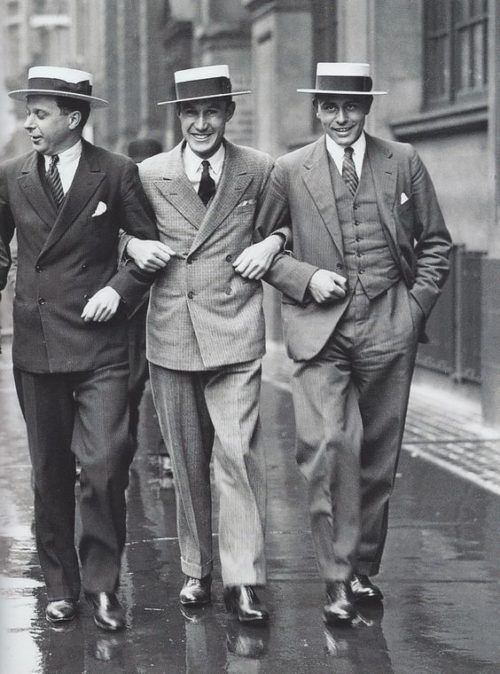
Gentlemen of the Golden Age
The economic hardships of the Great Depression impacted fashion, leading to more practical and less extravagant clothing. Suits retained a similar silhouette to the 1920’s but with narrower lapels and shorter jackets. Fabrics became more subdued and practical, with wool being a common choice. Fashion trends from 1930 to 1945 depicted a male silhouette having wide padded shoulders, a broad chest with a defined waist and straight legs. Shoulder pads were a big thing for both men and women alike. Europe and Britain caught onto this American trend which included high waisted tapered trousers that cuffed at the bottom, hence the term “Harry high pants“. However, during World War II, rationing affected clothing production, and men’s fashion became more utilitarian. Suits were simpler and less embellished.
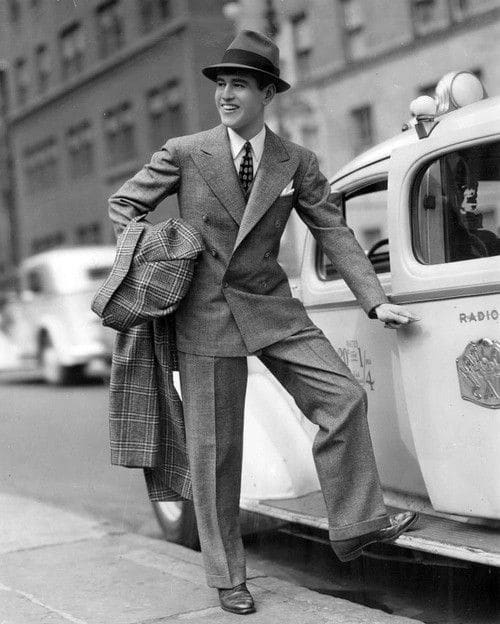
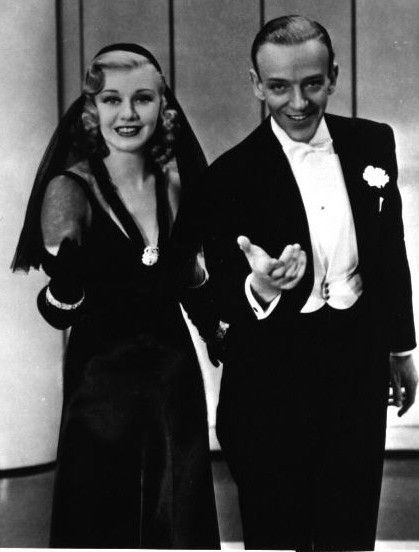
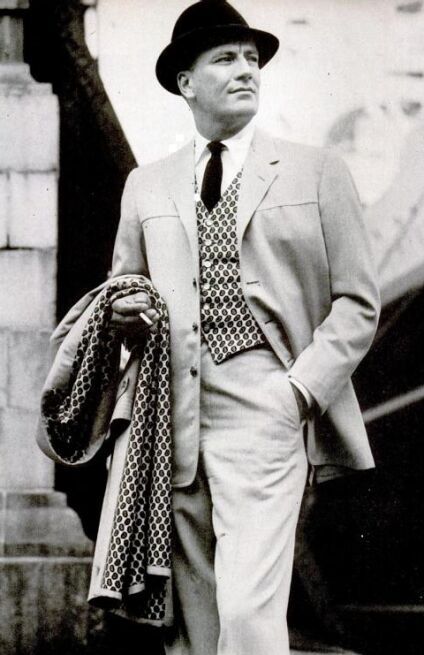
The era that was known as post Great Depression, and as World war struck again, fashion was still being influenced by the Golden Age of Hollywood and Silver Screen actors. Despite the ravagers of war, there was a shift in men’s fashion clothing trends which saw young men preferring to wear baggy trousers (continuing trends from the late 1920’s) called “Oxford bags“ where these shorter pants extended up to 16″ in width and exposing socks, favouring this looser more casual look, worn with a double breasted jacket. Vintage designers saw men wearing fabrics that took a different turn in bolder patterns, such as stripes, checks, plaids or windowpane patterns in a variety of colours. Coat collars were adorned with shearling wool or beaver, racoon fur. Not many are available, but learn more through Etsy, where you may find certain styles.
During this era, casual style jackets inspired by the military became fashionable like the Trench coat or Bomber jacket purchasable here, but also adorned with shearling wool, due to the growing interest in aviation. Flat hats were worn more widely amongst all classes and the fedora hat had a wider brim. Casual wear became increasingly popular as a variety of sports were being played, so day wear consisted of soft collared shirts and an assortment of knitted sweaters or cardigans, some with shawl collars, but eliminating the tie. Physical outdoor activity and a healthy suntan began to influence men’s fashion styles. Two tone suits with navy blazers and light trousers were the thing to wear whilst boating or yachting.
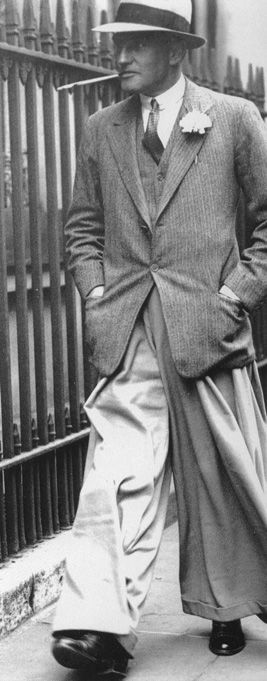
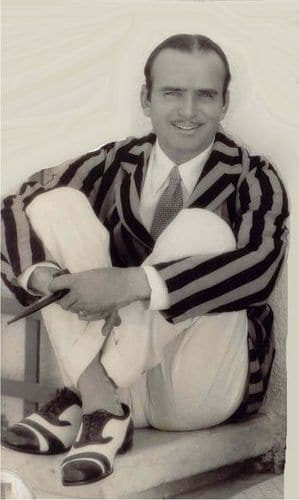
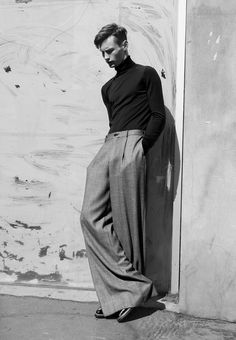
Mid Century Style
During this era, post war prosperity in the 1950’s saw a resurgence of more formal and tailored clothing. Suits regained their elegance, featuring broader shoulders, wider lapels, and a more fitted silhouette. Trousers became slimmer and often with a higher waist. Men were less conformed post war times, many with a renewed emphasis on education, and due to this the “Ivy League” became popular, influenced by collegiate styles with casual yet sophisticated elements such as well-fitted sweaters, polo shirts, and chinos for more relaxed settings. However, later bold but edgy styles emerged, led by Hollywood artists such as Marlon Brando or James Dean, (memorabilia tees available), who adopted undergarments to be used as outer garments in a fashionable sense, turning the principles of classic menswear on it’s head, whilst allowing the appropriation of blue collar clothing to be seen as the new fad. Music also played a big part in society as war times evolved into celebrations of peace across the world, with up and coming musicians such as Elvis Presley and Buddy Holly made an impact on stage as fashion icons. Slick back hair, buttoned down shirts with skinny ties and linen jackets rocked the crowds whilst other bands made use of Utilitarian workwear such as denim as their signature look. Trousers were shorter, cuffed or rolled up revealing white socks. Some classic pieces can be bought here, as you scroll down.
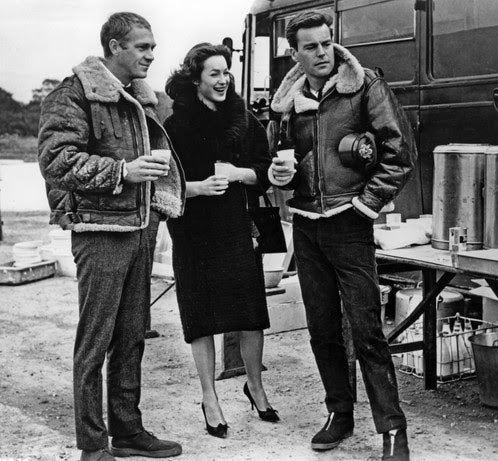
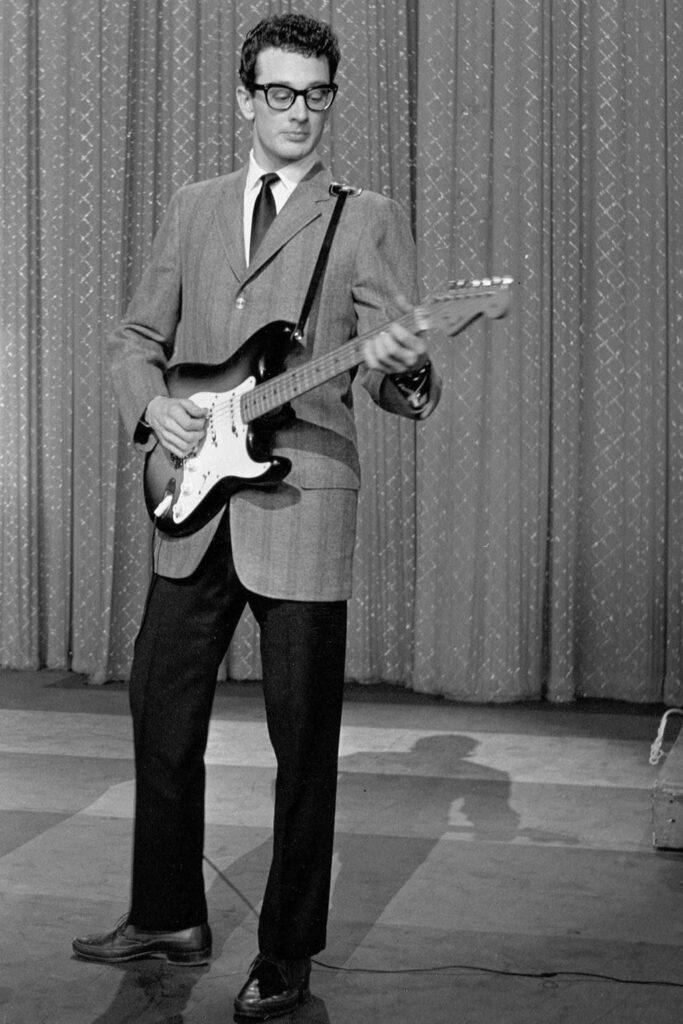

*As an Affiliate - I may earn a commission if you purchase an item after you click the links here on this site*
Fashions from the 1960’s witnessed significant changes in men’s fashion, with a shift towards a more relaxed and experimental style. Suit’s became much slimmer, featuring shorter jackets with narrow lapels. Bold patterns and bright colours gained popularity, especially in neck ties and shirts. A well dressed man was a role model for consumers but highly influenced by magazine and TV advertising, including the mod subculture that was also influencing fashion trends with tailored suits, slim ties and ankle-length trousers. French and Italian designers from Lanvin and Valentino who looked for new inspirations from 60’s fashion, designed printed satin bomber jackets and Palm tree print shirts which later were synonymous with Hawaiian Shirts. Shop for these iconic looks and styles here.
Their desire was to have a vintage style that can be recreated over and over, and these fashions set that trend for decades to come.
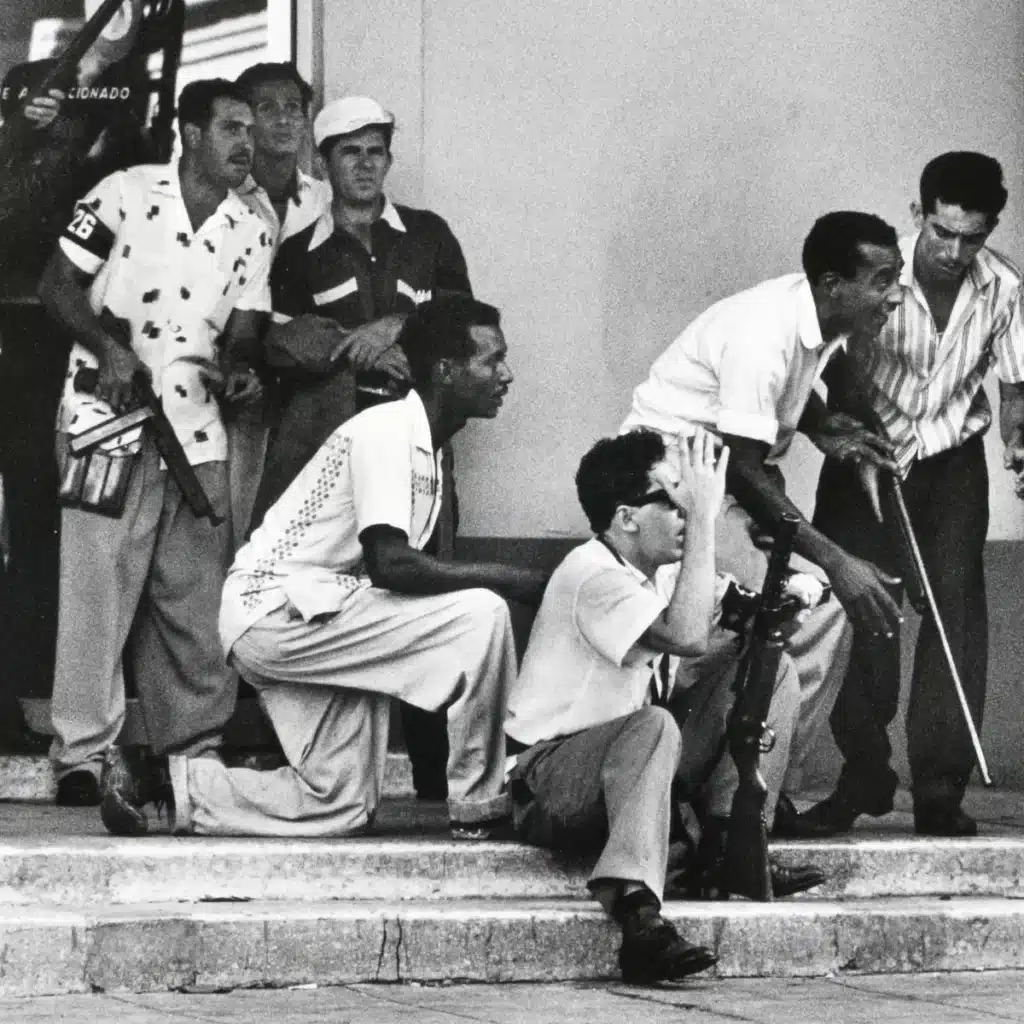
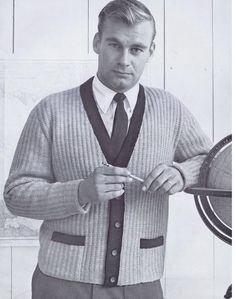
An era that celebrated classic styles and timeless elegance but often conservative with tailored office attire, with semi formal dressing in dark coloured suits with light shirts and ties for a sophisticated look. Vintage designer clothing exuded confidence and refinement in classic styles but with attention to detail, in every sense a well dressed gentleman. However, casual wear saw the rise of more comfortable yet stylish clothing, reflecting the changing societal norms of the time.
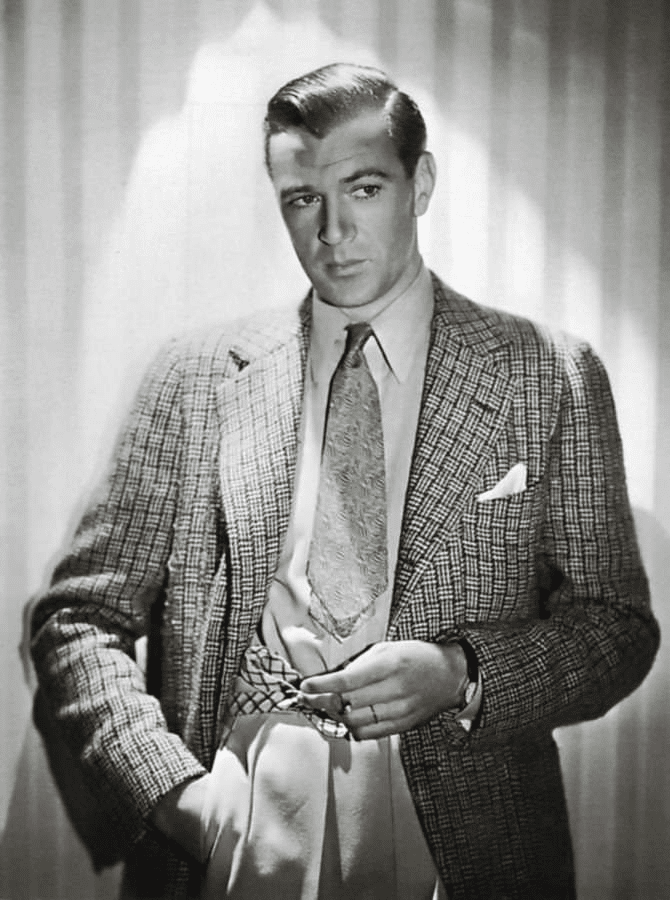
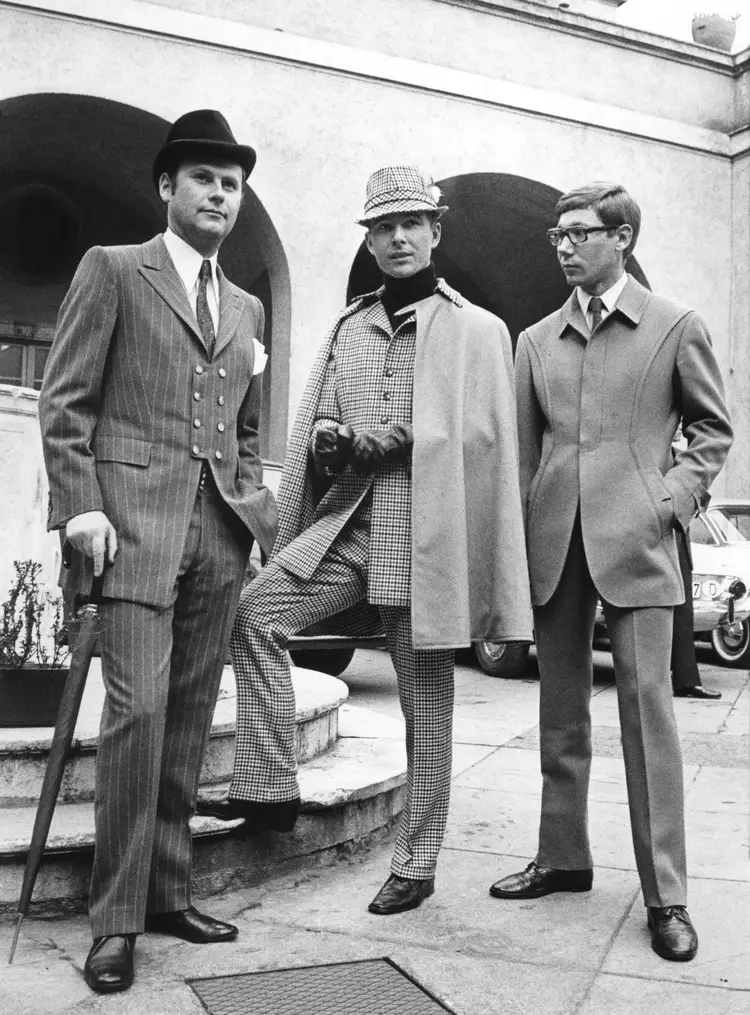
The Peacock Revolution and beyond
The “Peacock Revolution” was a term used to describe a significant shift in men’s fashion during the late 1960’s and early 1970’s. This period marked a departure from traditional menswear styles, embracing more flamboyant and colourful clothing, particularly in the realm of formal-wear. However not all men embraced this style of fashion, it was mainly the younger and more daring of society who embraced these trends.
Men’s fashion became more daring and flamboyant adopting bold colours, unconventional patterns, and extravagant designs. This style departed from the traditional subdued tones and conservative styles of previous decades.Tailored suits became slimmer, featuring bolder patterns, bright colours, and unconventional fabrics such as velvet, paisley brocade or cordouroy. For evenings they favoured ruffle shirts, wide lapels, bell bottom trousers, and platform shoes which became characteristic elements of this era’s fashion.
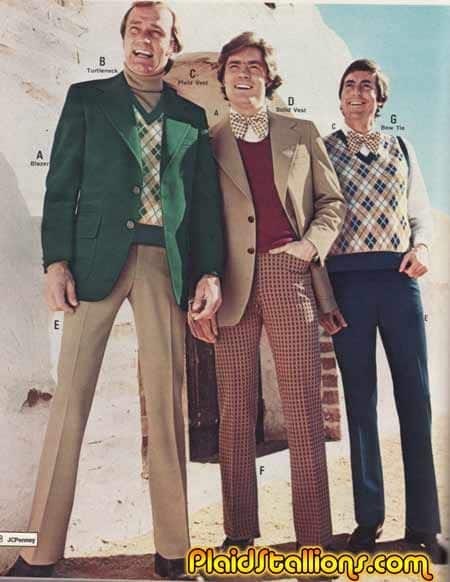
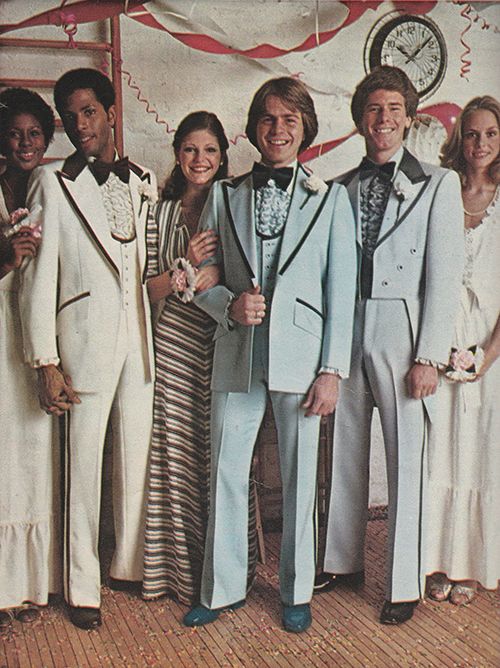
*As an Affiliate - I may earn a commission if you purchase an item after clicking one of the links*
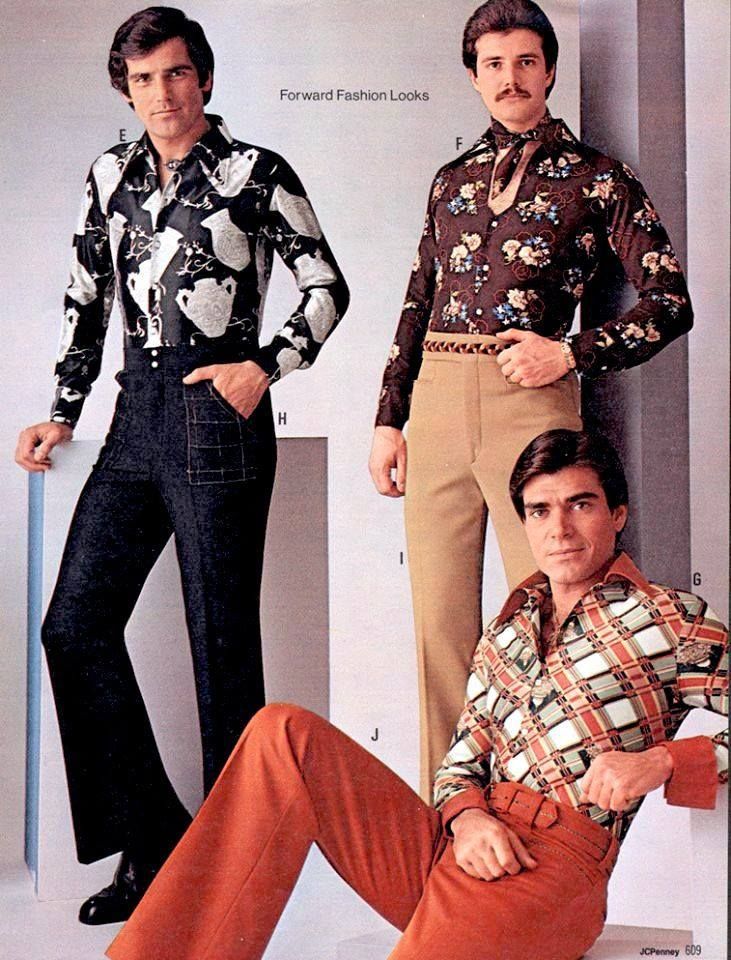
The Peacock Revolution reflected a cultural shift towards individualism and self expression. Men were more willing to explore and experiment with fashion, rejecting the traditional constraints of menswear, but this movement could not be any more prevalent as some would even refer themselves as “Dudes” or “Dandies” (a term given to the late 1800’s male, but re-prised in the 70’s). This movement also represented a more liberal and expressive approach to dressing, challenging the conservative norms that had prevailed in men’s fashion for decades. Affordable flamboyant inspired shirts can be found here. Contemporary fashion suits have adapted similar styling and for a modern version of flamboyant suiting, learn more about this listing on Amazon.
While the Peacock Revolution introduced more daring and extravagant styles, traditional men continued to prefer classic and conservative clothing, as this revolution was more reflective of a particular segment of the population embracing change rather than a universal shift in the perception of gentlemanly attire.
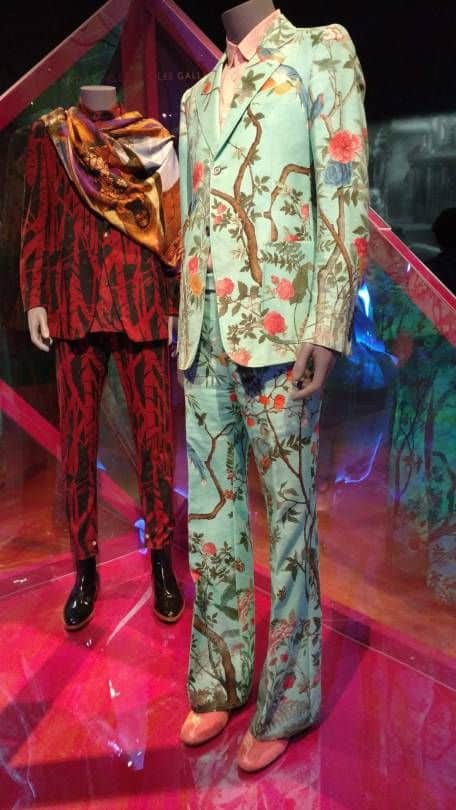
Hippie fashion (can be bought online) for men, and also during this era – it was characterized by a style that rejected mainstream trends and embraced a more relaxed, free-spirited look. Their clothing consisted of a myriad of relaxed but bohemian style clothing including:
*Tie-dye shirts in vibrant colours and often handmade but unique in their designs.
*Bell-bottom pants featuring bright colours or funky patterns.
*Denim jeans, jackets or vests personalized with patches, embroidery or other embellishments.
*Fringed vests or jackets in leather or suede as a popular outerwear.
*Flowing loose-fitting shirts or tunics made of natural materials like cotton or linen, featuring ethnic or psychedelic prints.
*Footwear consisted of comfortable sandals or leather moccasins preferred over formal shoes, however some chose to go barefoot as a symbol of freedom.
*Accessories and Jewellery included, braided headbands or bandanas, wide brimmed floppy hats or knitted skull caps, beaded necklaces bracelets and rings, which were generally of natural materials such as wood, stone or shell.
Some hippies incorporated natural elements into their attire which saw them wearing clothing from organic or recycled materials reflecting their connection to nature and their anti establishment beliefs. The hippie movement in fashion was diverse and individualistic, but not everyone embraced this. However these items were symbolic of the style which emerged during that time and contributed to the overall counter cultural fashion statement.
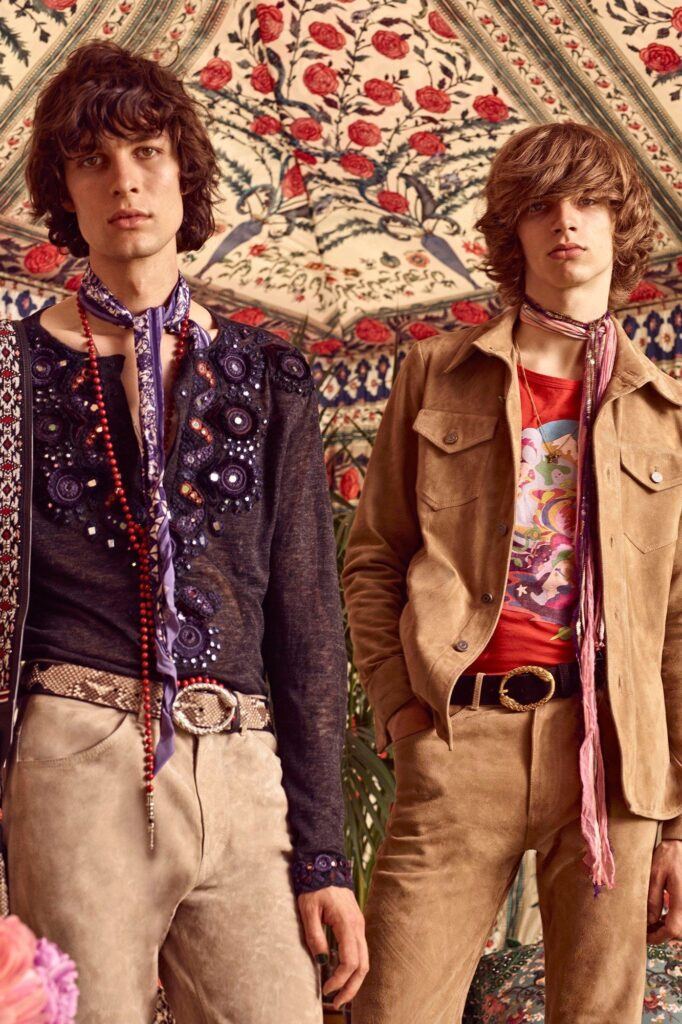
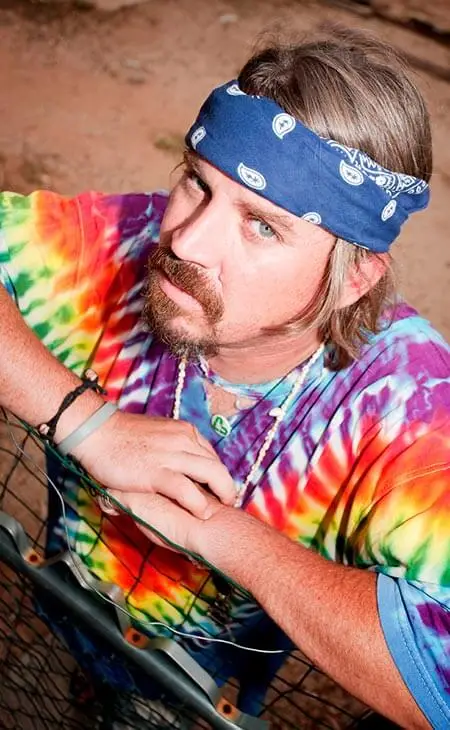
During the disco and soul era of the 1970’s, men’s fashion embraced flashy and flamboyant styles that reflected the vibrant and energetic music scene of that time. Key elements of this disco/soul era included:
*Safari or Leisure suits, they were the most iconic clothing items of this era, and in either two or three piece with a wide collared shirt and tight fitting, high waisted trousers with flared legs, learn about these at Etsy Made from synthetic fabrics such as polyester that came in bold colours or flashy patterns. Three piece suits were more tailored and sophisticated in bold colours or eye catching patterns made from luxurious fabrics. Cumberbund fashion was emerging as a fashion accessory, replacing belts to highlight the slacks for formal attire.
*The shirts (available from Amazon), made a real statement with their oversized pointy collars featuring loud patterns and bright colours. Some with metallic accents and made from silk or satin fabrics. Some shirts were made specifically for dancing and were made from stretchy fabrics such as soft polyester for more freedom of movement.
*Bell-bottom pants ( buy them online), with platform shoes were the rage, and thus became the staple of disco fashion at the time. The pants were long and mostly covered the shoes which had higher heels and came in various style, colours, and materials which added height and glamour to the look.
*Accessories (learn about how they incorporated into the style), and were a must – to complete the look, hence tinted sunglasses, wide brimmed hats, thick gold chains or medallions and wristwatches were worn as statement pieces.
*Grooming and style hair was a must, unlike the hippy era – when grooming was questionable? Men fancied meticulously styled hair which was either afro, long or flowing with little or no side-burn. They would pay attention to detail when it came to grooming, to maintain a polished and fashionable appearance.
The disco and soul (inspired attire), era, was characterized by bold colours, flashy materials with an emphasis on glamour and self expression. It was a time when clothing was used to showcase one’s personality and embrace the vibrant energy of the music and dance culture.
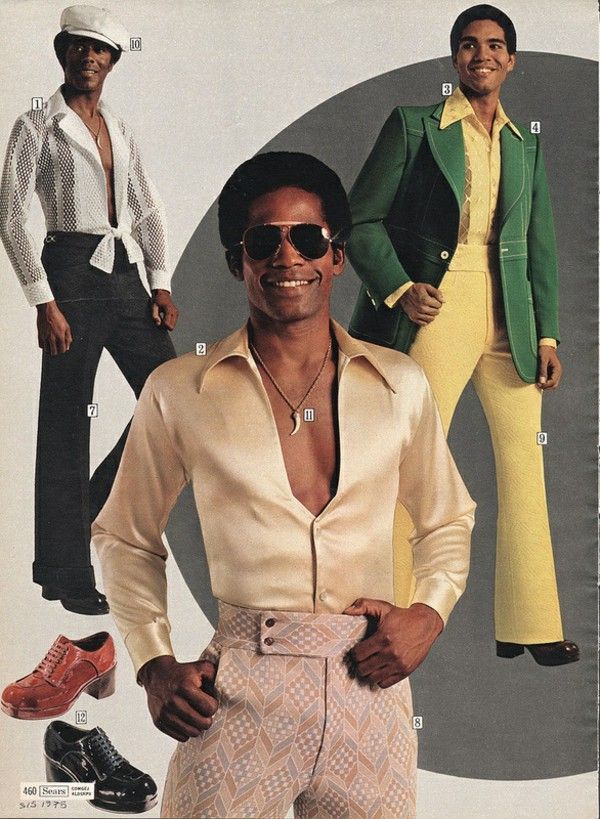
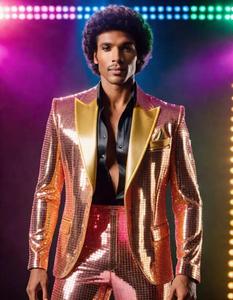
All Things Bold or Flouro
The 1980’s was an era of bold, vibrant fashion for men. Some key elements that characterized the flamboyant and flourescent fashion trends at the time that were influenced by new wave or post punk music.
- Neon hues were everywhere in 80’s fashion. Men wore clothing in bright flourescent shades like neon pink, green, yellow and orange. These colours were featured in various clothing items such from shirts, and jackets to pants and accessories.
- Muscle shirts and tank tops were designed tight fitting in bright attention-grabbing colours and popular among men. These tops were paired with contrasting colours such as black or worn under open jackets.
- Track suits gained immense popularity, especially those made from shiny synthetic fabrics in bold colours. These could be worn both for athletic activities and as casual wear.
- Parachute pants were very loose fitting featuring a characteristic baggy silhouette with tight cuffs at the ankle made from nylon or synthetic materials in a variety of bright colours or geometric patterns or prints. This style gave rise to oversized clothing including baggy T-shirts, sweat shirts and jackets that were worn in bright but clashing colours.
- Hightops and sneakers were particularly fashionable which came in bright colours and sometimes neon accents. Brands such as Nike and Addidas were popular for their bold shoe designs.
- Jewellery continued to dominate mens fashion accessories in chunky gold or metallic jewellery pieces including thick chains, bracelets and even earrings.
- Men’s accessories included neon coloured belts, suspenders, and headbands. Sunglasses continued to be trendy in brightly coloured frames.
- Men’s hairstyles, like women’s, were bold and flashy. These included the Mullet, Mohawk or slicked back styles with volume and gel to hold it in place. Some would go to extremes and have their hair dyed bright colours or would perm the back of the Mullet.
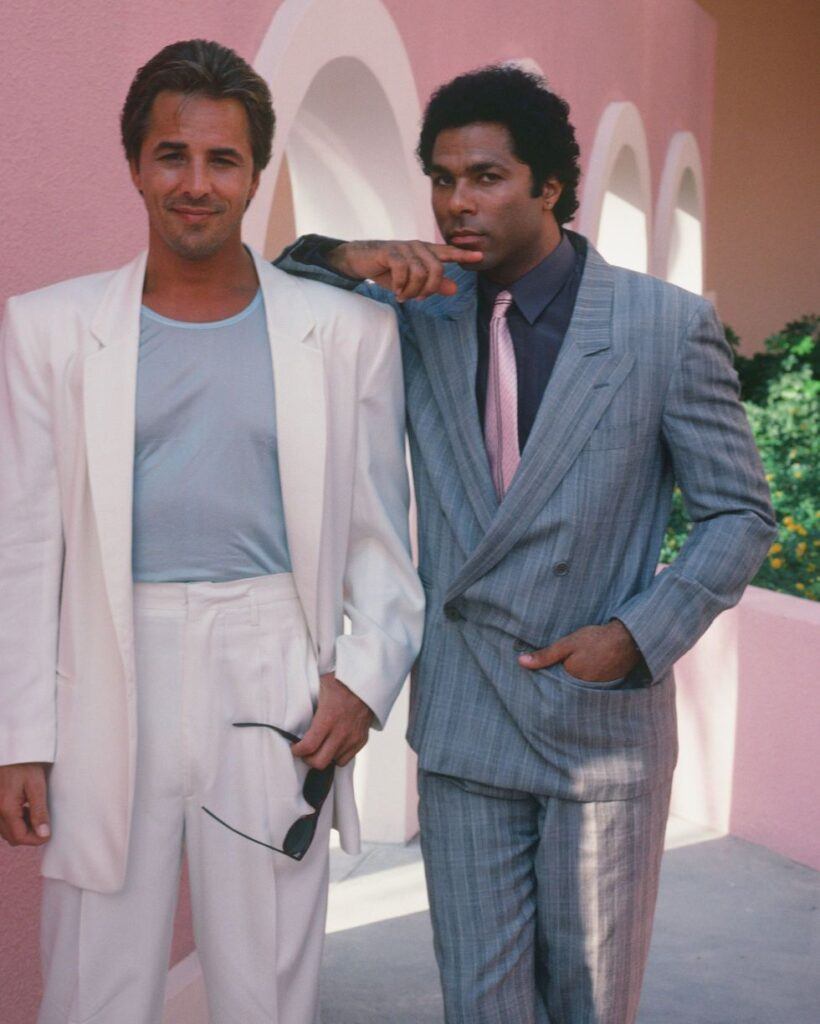
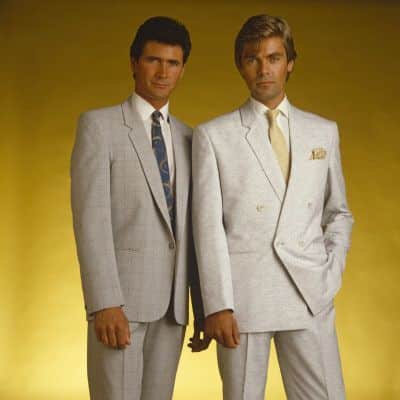
Younger men preferred to make a statement when power dressing, with the return of thinner ties to accessorize sports jackets, together with rolled up sleeves and pleated pants tapered at the ankles, it was considered an acceptable alternative to wearing full suits or even safari suits, favoured by older gents. However this era was characterized by a fearless embrace of bold colours, learn about these loud pattern ensembles that are available today, but with an overall sense of flamboyance. It was a decade where self expression through clothing was celebrated, and men’s fashion was no exception in exploring the wild and vibrant trends of the time.
Due to a global recession and the need for low maintenance clothing, casual styles emerged as acceptable outerwear, and denim once again continued to be a favourite amongst men and women. Worn as a matching sets was considered in vogue, but some would say perhaps a faux par? never the less, any double denim ensemble was jokingly referred to as the “Canadian Tux“. This evolution continued in the 90’s as different variations were introduced.
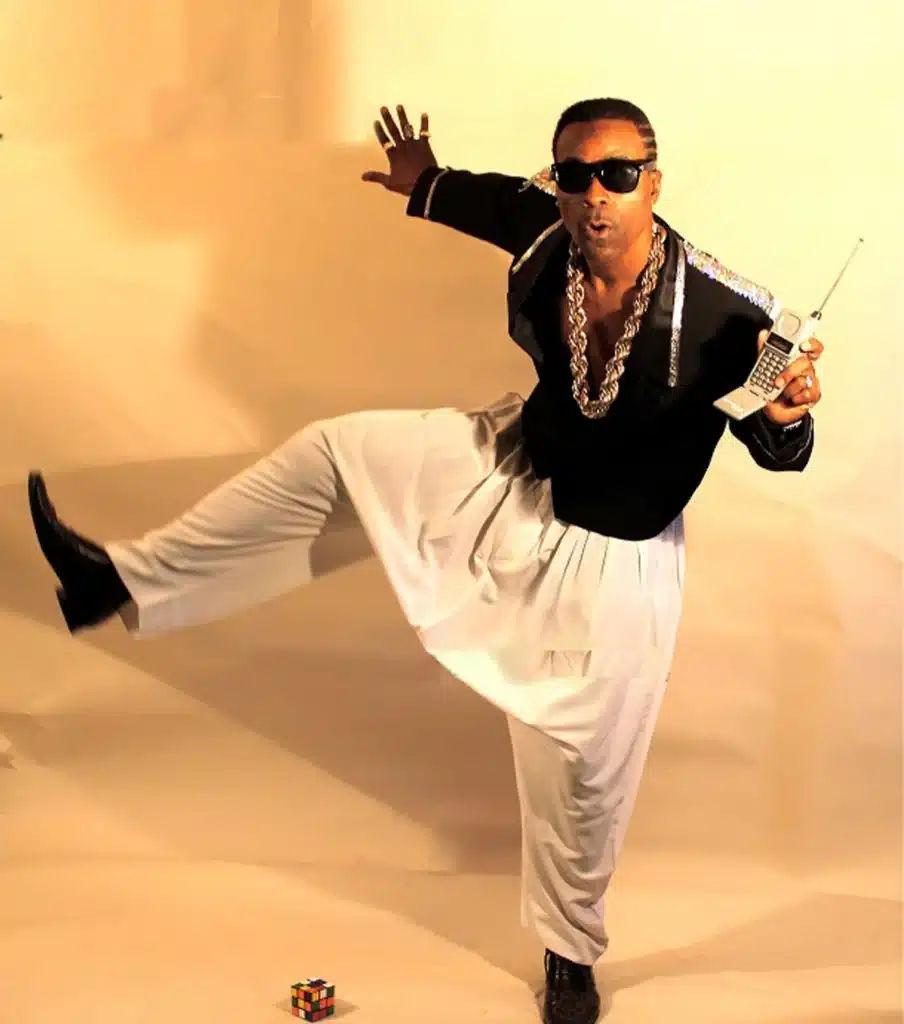
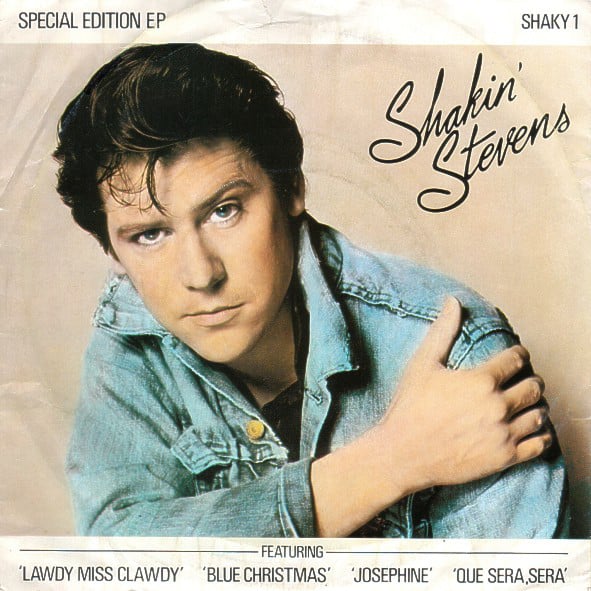
The “College Boy” or “Preppy Look” with today’s inspirations, fashion styles originated from a status symbol, worn by wealthy guys who attended Preparatory or Ivy League schools in the early 1900’s. This style was adopted by women from the mid 1930’s when Levi jeans were released to all females. Men also adopted this look with big baggy jumpers, oversized printed shirts with high waisted jeans, polo shirts, loafers or boat shoes and hush puppies teamed with bomber jackets, plaid blazers and pleated khaki trousers. Some even adopted a style where a sweater would be knotted over the shoulders during social sporting activities. With the rise of new designers such as Tommy Hilfiger, Calvin Klein and Lacoste, were able to churn out preppy men’s fashion for the general public. .
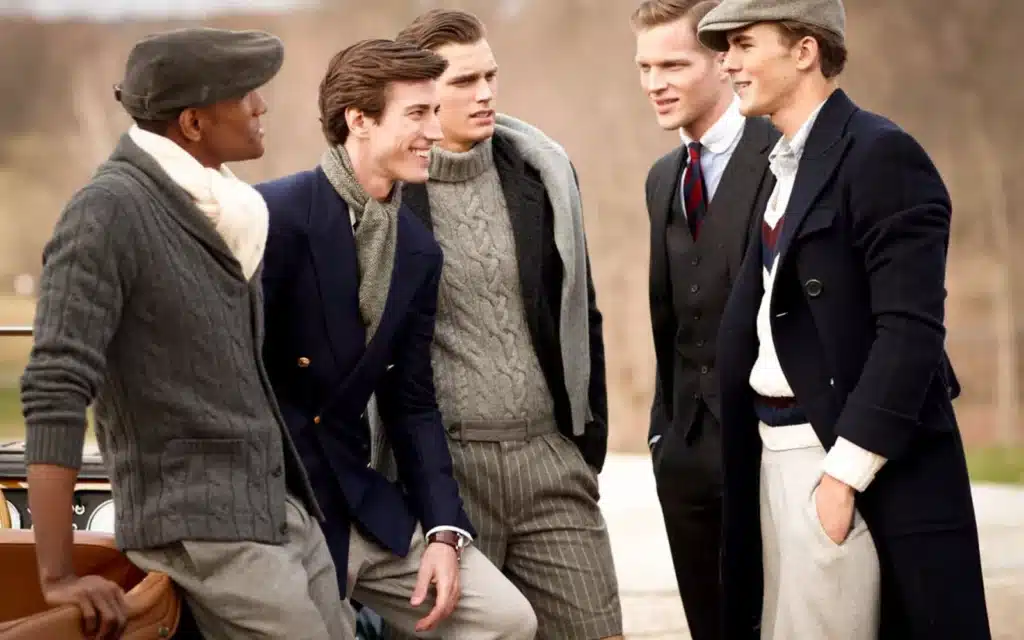
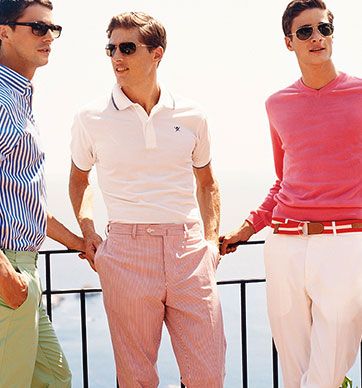
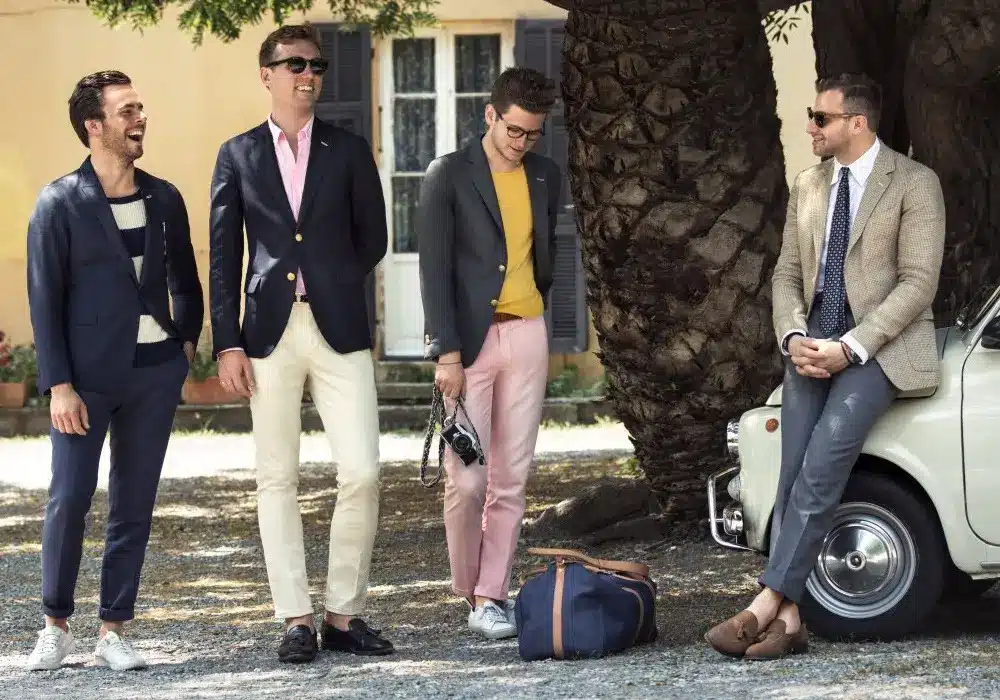
Gothic styles entered the late 1980’s, but some can be reprised today, also known as punk fashion. Inspired by post punk music bands that included Leather Jackets and Doc Marten boots were worn by both sexes. The gothic trend continued into the 1990’s. Nonetheless, other alternative clothing to the power suit was being favoured in Australia, South African, India, China and Zaire. The Safari jacket, Nehru or Mao suit remained popular in these countries while in Zaire it was known as the Abacost, and was worn with a leopard print Fez style hat. During this time, the African post decolonisation suppression of western fashion forced young African Sapeurs to rebel, and by idolising the music of “King of Rumba Rock – Papa Wemba”, invested in expensive designer suits from Italy and France. This rebellion continued till the deposition and death of their dictator Mobutu, and the outbreak of civil war in Zaire during the late 1990’s.
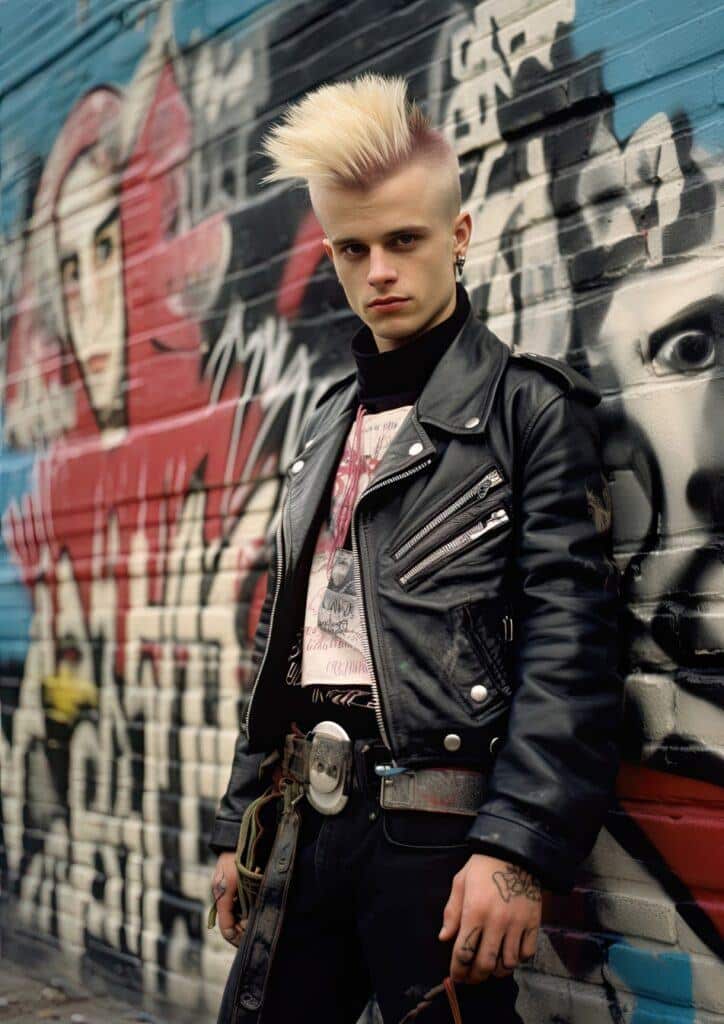
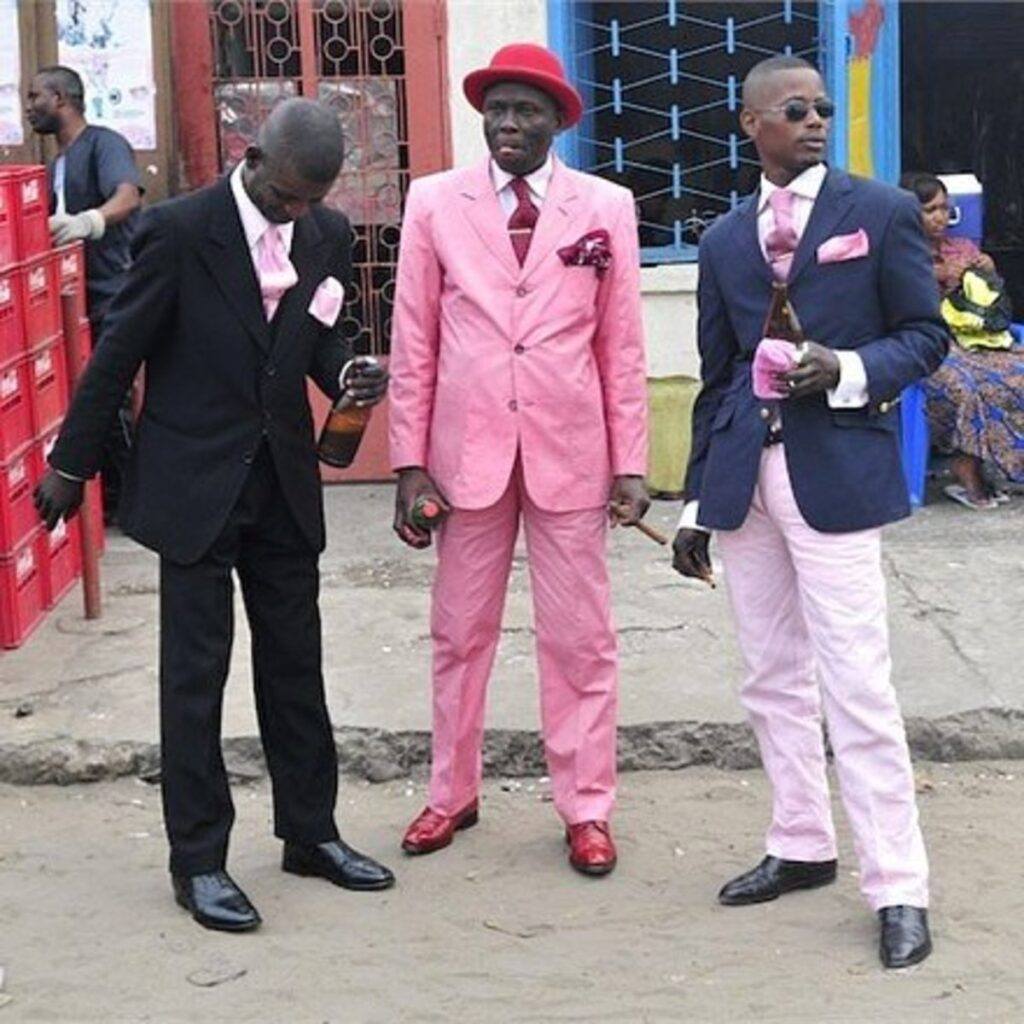
Hawaii’s custom dress of Aloha shirts and Bermuda shorts (well sort after and often purchased today, known as men’s Hawaiian fashions) consisted of casual attire worn on Fridays, with the shirt traditionally left loose and where daily business was conducted in this acceptable dress code. This custom was adopted after spreading to the US mainland where Fridays were known as Aloha or Casual Fridays.
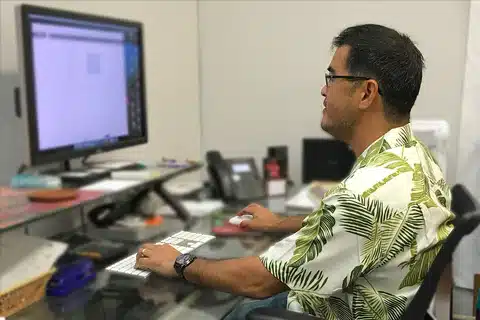
The 1980’s era was characterized by a fearless embrace of bold colours, loud patterns and with an overall sense of flamboyance. It was a decade where self expression through clothing was celebrated, and men’s fashion was no exception in exploring the wild and vibrant trends of the time.
Vintage clothing can add a touch of sophistication, individuality, and even a sense of history to ones style. When paired and worn appropriately, vintage pieces can contribute to a refined and distinguished appearance such as the wearing the right accessories where simple choices of can add elegance to a gentleman’s outfit. However, the essence of being a gentleman lies more in the behaviour, attitude, and character, rather than solely in the choice of clothing.
Thanks for reading my post, and I hope this inspires all men to explore their inner vintage style. Feel free to leave any comments below.
Kind regards
Helen
Connect with us via our socials or get in touch below:
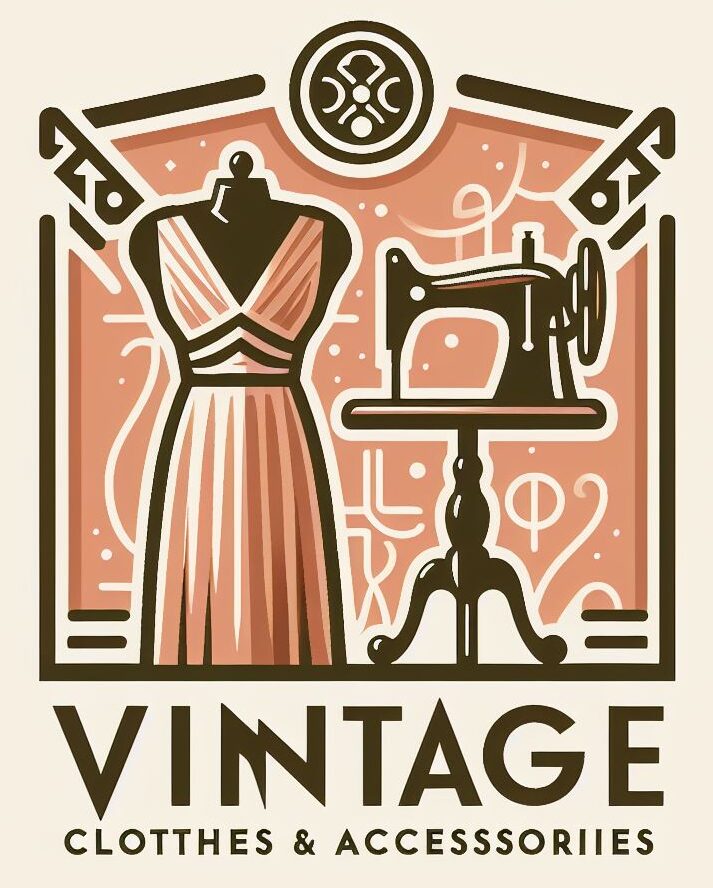
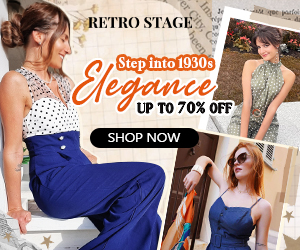
Hi Helen,
I must say, you have a knack for bringing the age-old question about clothes and their impact on man’s image to life in a fresh and relevant way.
And those vintage photos you’ve included? Wow, they’re just amazing, offering us a captivating glimpse into the past and how gentlemen used to style themselves. Your post is a fascinating visual journey!
Keep up the fantastic work, looking forward to your next post!
Hi Jivita,
thanks so much for your response. It has been an interesting journey for me and much to learn along the way. I try and always look for interesting images that stand out including formating it in a way that looks visually appealing.
You are welcome to view any of my posts. I will keep updating the website as I go along.
Kind regards Helen.
Well such great information on your post. I agree that vintage clothes does make the gentleman
It was a fun post to write, hope it helped you?
That was a good read I love your post and contant helen
It’s a fun way to help the gents get organised with their wardrobes.
What a great topic—I really enjoyed the perspective! In my opinion, vintage clothing absolutely contributes to the image of a gentleman, not just because of style, but because of the intentionality behind it. Choosing vintage often means paying attention to quality, detail, and timeless design—traits that reflect a sense of pride in presentation.
There’s also something about wearing clothes with a story that adds depth to a person’s character. It’s less about following trends and more about expressing individuality with respect for the past.
That said, I think being a true gentleman is also about how someone carries themselves—vintage style can enhance that image, but it’s the values underneath that truly complete the look.
Thanks for sparking such a reflective and stylish conversation!
thanks very much for your kind words Tommy, glad you enjoyed it.